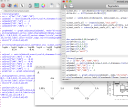You might imagine that the life of an ecologist is spent mostly in beautiful and remote places. While this is sometimes true, a large fraction must also be spent in front of a computer. The reason is that science is only partially about making measurements or doing experiments. These parts are the glamorous ones, insofar as ecology is glamorous. But there is much more work to be done behind a desk, late at night, over long months. It is this hidden and quiet part of science that I’d like to show you. Below are four vignettes from the scientific process.
The first aspect is data management and storage. Numbers, acquired from hard work in the field, are only useful if they are organized, and (nowadays) readable by a computer. Above, you are seeing raw output of the BIEN database, which stores tens of millions of observations of plants from around the world. These observations represent hundreds of years of fieldwork and thousands of scientists’ work – now becoming a viable resource for understanding biodiversity, only because they are managed in a single location. I have to spend long hours organizing and documenting my own data, when I am not lucky enough to use a shared resource like this one. But it is a wonderful feeling when a day’s fieldwork becomes a datasheet becomes a computer file, because then – and only then – does that information become immortal, and analysis possible.
The second aspect is data analysis. Scientific hypotheses are most commonly addressed using statistical methods For projects that are based on large datasets and complex methods, it is important to make analyses repeatable, so that the answer to a certain question can be updated as more data are obtained. Here you are seeing a structural equation modeling analysis I am doing for a project on how aspen (Populus tremuloides) trees respond to changing climates. All the analyses have been coded in R, a scientific programming language. Much of my time is spent writing code to make the computer test the hypotheses I’m interested in.
The third aspect is writing manuscripts for publication. Scientific results can only be useful if they are made available to other scientists and the broader world of decision makers and the interested public. Achieving this goal is far easier if discoveries are presented using clear and concise writing. I spend many long hours writing and revising manuscripts. Here you can see part of an appendix for a paper on paleoclimate change which has been in progress for the better part of a year. Publications are permanent records, so it is very important to get things right. Sometimes I will go through ten or twenty drafts before my collaborators and I are happy.
The fourth aspect is navigating the world of publication. My manuscripts get submitted to journals where they are subjected to a peer-review process where other scientists provide critical feedback on my ideas – and sometimes identify (what they think are) problems that need to be resolved before the study is suitable for publication. Here you can see part of a letter I received last week from an editor at Ecology Letters. Unfortunately this particular manuscript was very controversial and was rejected from their journal, so I now have more work to do on this project. Rejection rates at some journals are near 95 percent – so it can be very difficult to get published, even when you think you are doing good work. Navigating the world of journals takes far more time than one might hope. Ecology has not yet moved to the physics model of open pre-publication archives (e.g. arXiv) nor a strong research blogging community, though I think these would both be important advances.
And of course I haven’t written anything about the post-publication world. The impact of a study can be multiplied through press releases, media coverage, meetings with decision-makers, discussions with other scientists, and so on. This is the subject of another even longer post, or an exploration of the wonderful resource, Escape from the Ivory Tower.
I hope you can see that there is much unsung work that goes on in the scientific shadows, filling the emptiness between a first expedition to a jungle and a final announcement of a new finding. Much as I don’t like sitting at a desk, it is necessary work – and lets us get back to the business of exploring and discovering!







Comments
4 responses to “Desk biology”
I would have expected a better collaboration scheme than MS Word track-changes from someone who still maintains the website sourcecod.com. As always, your field pictures are awesome.
MS Word is standard among ecologists and ecological journals, so we are locked in to the system. One journal I am preparing a revised manuscript for right now does use a different system – any changes to the revision should be hand-colored in red text in MS Word. So you can see that we are not computer scientists, and are unlikely to become them soon. But I am glad you are enjoying the photos!
Great post about an important reality, Ben. Thanks for sharing it.
[…] researchers devote miserable hours in dark basements to what a fellow graduate student describes as rather unglamorous data crunching and document editing? Why participate in a Ph.D. program and career that even the […]